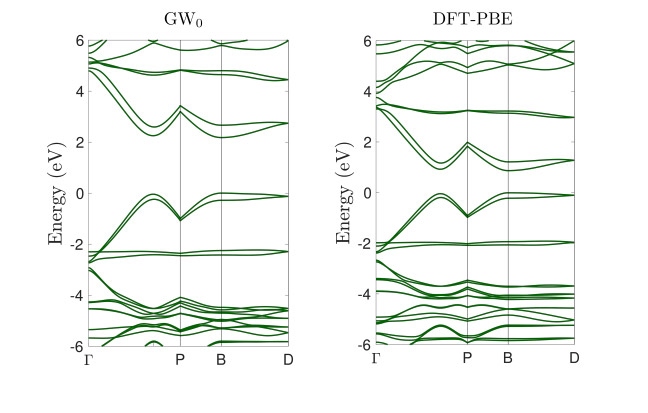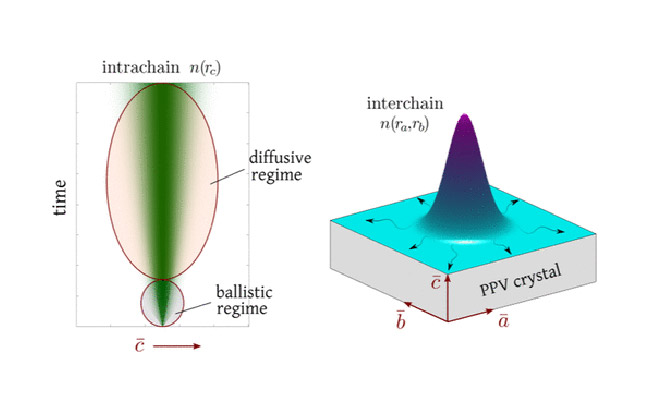

Platform Leader: Jared Cole
Deputy Platform Leader: Asaph Widmer-Cooper
Exciton dynamics in materials and across hybrid interfaces are highly complex and are dependent on nanoscale form and structure, spin polarisation and vibrational properties.
The aim of this platform is to develop computational modelling techniques that can help interpret and predict exciton behaviour from the nanoscale to the device level, and to understand the exciton dynamics in single molecules or organic-inorganic hybrid systems.
We are employing a combination of different theoretical approaches to examine the interplay between electronic coupling, spin and structure on exciton diffusion and delocalisation on scales ranging from the atomistic (single molecules and quantum dots) to the device level (bulk films).
Previously, only very limited information has existed on the structures that control optical and electronic properties at the intermediate scale.
Given the spatial and energetic disorder that is often observed at intermediate length scales, relationships become much more complicated in devices, and no universal theoretical insight exists between morphology (form and structure) and device physics.
Overcoming this shortfall is critical towards the optimisation of devices in areas ranging from solar energy to sensing, lighting and security.
Researchers
International Collaborations
Exciton Science Nodes
| Name | Node |
|---|---|
| Jared Cole | RMIT |
| Asaph Widmer-Cooper | USyd |
| Salvy Russo | RMIT |
| Alison Funston | Monash |
| Paul Mulvaney | UniMelb |
| Trevor Smith | UniMelb |
| Girish Lakhwani | USyd |
| John Sader | UniMelb |
| Dane McCamey | UNSW |
| Name | Node |
|---|---|
| Mykhailo Klymenko | RMIT |
| Igor Lyskov | RMIT |
| Nastaran Meftahi | RMIT |
| Yawei Liu | USyd |
| Stefano Bernardi | USyd |
| Martin Cyster | RMIT |
| Dongchen Lan | UniMelb |
| Jesse Collis | UniMelb |
| Mahyar Madadi | UniMelb |
| Mohammad Aminpour | UniMelb |
| Name | Node | Student type |
|---|---|---|
| Nicholas Liu | UoM | PhD |
| Joseph Johnson | UoM | PhD |
| Ashish Sharma | USyd | PhD |
| Peijing Lu | UoM | Masters |
| Alex Nunn | UoM | Masters |
| Tim O’Sullivan | UoM | Masters |
| Carl Belle | RMIT | Masters |
| Tyler Hughes | RMIT | Masters |
Junzhong Wang, Kuai Yu, Yang Yang & Guo Ping Wang (College of Electronic Science and Technology, Shenzhen University, China)
Gregory V. Hartland (Department of Chemistry and Biochemistry, University of Notre Dame, USA )
Stefano Stassi, Giulia De Laurentis & Carlo Ricciardi (Department of Applied Science and Technology, Politecnico di Torino, Italy)
Katarzyna Bejtka & Angelica Chiodoni (Center for Sustainable Future Technologies, Istituto Italiano di Tecnologia)
Jürgen Lisenfeld (Karlsruhe Institute of Technology, Karlsruhe, Germany)
Clemens Müller (ETH Zürich, Zürich, Switzerland)
Egor Trushin (Departmemt of Theoretical Chemistry, Universität Erlangen−Nürnberg)
Thorsten Hansen (Department of Chemistry, Copenhagen University)
The key focus of Platform 2.3 is to develop computational models of excitonic materials and structures. These models are then used to understand the experimental measurements and design new experiments or devices. In general, excitonic materials are particularly difficult to describe using computational models. Many of the standard approaches do correctly describe the energies and movement of an exciton. In this platform we are using cutting edge simulation techniques to understand how excitons are created, how they move and how long they live.
A highlight of 2019 was the first demonstration of our multi-scale modelling capability. The RMIT (Cole, Russo) and UNSW (Schmidt) teams studied the movement of triplet excitons in a standard polymer (PPV) as a test material1. Polymers are particularly interesting as they can be thought of as a mass of tangled string. The key question is how do excitons move along and between the strings. We were able to use an advanced quantum chemistry technique (called multi-reference configuration interaction) to compute the energy of these excitons and how they move along and between the strands of polymer. We then used these calculations to develop an effective model using “open-quantum systems” theory which in turn was fitted to a large-scale diffusion model. This use of three different modelling techniques allowed us to go from the atomic scale up to the millimetre scale. This approach can now be used for other materials of interest to the Centre.
Another key result of the last 12 months was the proposal of silicon nanowire detection system for probing exciton dynamics at an organic/inorganic interface2 (RMIT, Cole and Russo). Inorganic semiconductors (silicon) dominate the current photovoltaic market, however their ability to absorb energy from the sun is limited due to the finite spectral response of silicon. A key aim of the Centre is to develop novel organic semiconductor materials which can improve the spectral response, absorbing more of the incident energy in sunlight. However, an important challenge is understanding how and when do excitons cross the boundary between organic and inorganic materials. Our proposed nanowire detection system provides an entirely new platform for studying this important problem. By monitoring the charge flow through the nanowires, we can obtain spatial and temporal information about the movement of excitons in the material interface. We are currently developing proof of principle experiments to be done in the Centre to further develop this concept (UoM Mulvaney, UNSW McCamey, Monash Funston).
To understand the lifetime and movement of excitons in molecularly systems, it is important to understand the role of vibrations. At room temperature, molecules can jitter and rotate at the atomic scale, which can decrease or increase the exciton transfer rate. To better understand these atomic scale vibrations, it is important to have well understood models of vibrations. In 2019 the Centre (UoM, Sader) published several important new results on vibrational systems. In collaboration with Shenzhen University and University of Notre Dame, strong vibrational coupling in ultra-high frequency plasmonic nanoresonators3 was demonstrated. These resonators achieved higher enough quality factor products to enable ground state cooling. This will enable a platform for observation and control of the quantum behaviour of phonon modes in metallic nanoparticles. In a collaboration with Politecnico di Torino, Sader showed that weak coupling between nanomechanical devices in resonator arrays can be used to parallelise mass spectrometry4. This enabled the simultaneous detection of resonators placed at distances a hundred times larger than their own physical size, facilitating for very large-scale integration. This now allows excitonic coupling in nanomechanical arrays to be detected using a single readout.
One of the key challenges that the Centre faces is working with the multitude of possible new molecules and materials that could be used for photovoltaic applications. The time required to develop and screen each of these materials is significant, however multi-scale modelling and machine learning techniques can reduce this development time drastically. Within the Centre, we are developing a software tool to interrogate publicly available Data Tables of Material Properties and material performance (obtained using Material Databases software tool) and produce (via machine learning algorithms) metrics to predict material performance in similar systems (RMIT, Russo). Several key modules have been written and tested in 2019 with a planned public release in the next 12 months. This software tool will enable high speed screening of potential new materials before they are selected for testing in the lab, resulting in savings of both time and resources (RMIT Russo, Monash Bach).
The USyd group (Widmer-Cooper) have developed a versatile model and simulation method for studying phase behaviour and dynamics in colloidal nanorod suspensions5. An extension of this model was used to explain the self-assembly of spherical and rod-shaped nanoparticles with positional control6, in collaboration with Monash (Bach) and CSIRO/RMIT (Gomez). This model is currently being used to model and study the formation of binary nanorod assemblies, which may reduce loss mechanisms in LSCs. In addition, the model is being used to explain the origin of rod alignment in electrophoretic assembly experiments, in collaboration with UoM (Mulvaney), and to explain the origin of chiral gels formed via helical assembly of molecular chromophores, in collaboration with USyd (Lakhwani). The USyd group (Lakhwani) performed circularly polarised light scattering experiments on polymer aggregates and advanced existing models to enable extraction of structural properties such as the size, orientation, and periodicity of helical polymer aggregates. They developed certain guidelines that would allow community to interpret their scattering data against the model and obtain information about the internal structure of their aggregates.7
1. Igor Lyskov et al., ‘First-Principles Calculation of Triplet Exciton Diffusion in Crystalline Poly(p-phenylene vinylene)’, J. Phys. Chem. C 2019, 123, 44, 26831-26841.
2. Mykhailo Klymenko et al., ‘Probing charge carrier movement in organic semiconductor thin films via nanowire conductance spectroscopy’, ACS Applied Electronic Materials 2019 1 (8), 1667-1677.
3. Wang, J.; Yu, K.; Yang, Y.; Hartland, G. V.; Sader, J. E.; Wang, G. Ping. Strong vibrational coupling in room temperature plasmonic resonators. Nature Communications 2019, 10 (1) 1527.
4. Stassi, S.; De Laurentis, G.; Chakraborty, D.; Bejtka, K.; Chiodoni, A.; Sader, J. E.; Ricciardi, C. Large-scale parallelization of nanomechanical mass spectrometry with weakly-coupled resonators. Nature Communications 2019, 10 (1) 3647.
5. Liu, Y.; Widmer-Cooper, A. A versatile simulation method for studying phase behavior and dynamics in colloidal rod and rod-polymer suspensions. The Journal of Chemical Physics 2019, 150 (24) 244508.
6. Lloyd et al., Self-assembly of spherical and rod-shaped nanoparticles with full positional control, ˆ, 2019, 11, 22841-22848.
7. Sharma et al, Circular Intensity Differential Scattering Reveals the Internal Structure of Polymer Fibrils, J. Phys. Chem. Lett., 2019, 10, 7547
Following feedback from ISAC in 2018, Platforms 2.2 and 2.4 were combined into the current P2.3. As this is a central fundamental theme, exciton transport insights and multiscale modelling provides guidance across all platforms and capabilities, most particularly 2.2, 1.1 and 1.2. The outcomes of the project have the potential for high impact publications and full fundamental understanding of the behaviour of excitons in nanoscale systems.
Initially (2017-18), there were significant delays in postdoc and PhD appoints. In addition, there was a need to develop new models and understand the requirements of the other platforms. This situation has largely been resolved and work is proceeding on all fronts.
In 2020, a range of modelling techniques will continue to be explored and benchmarked. In addition, there are an increasing number of projects underway using existing techniques to model experimental systems within the Centre and with collaborators.
Areas of interest within the platform at the moment are to:

Electronic band structure of PPV crystal

Multiscale Modelling of fast and coherent intrachain and a slow and incoherent interchain in PPV